Heading out the door? Read this article on the new Outside+ app available now on iOS devices for members! Download the app.
When you enter a challenging pose like Ustrasana (Camel Pose), you need all the inner and outer strength you can get. If you lack the confidence or strength to lean back into it, says Laura Christensen, a San Francisco Bay Area yoga teacher, you’ll likely flop into the pose and take the brunt of the backbend in your neck or lower back. The first step toward resolving this problem is to tune in to your breath, since the breath is a way to harness and direct the prana (life force) that’s within each of us. “It’s difficult to feel confident and trust yourself if you don’t feel powerful inside or if you are cut off from the very energy that enlivens you,” she says. “Each of us contains within an incredible wellspring of power, but it’s not always activated, and we don’t always feel it.”
Breathing with awareness not only helps you tap into your inner strength but also helps keep you stable in the places you need it most. Christensen compares the action of filling the torso with breath to filling a balloon with water: When there’s no water in the balloon, it’s floppy. The water gives it shape and form. Similarly, when you fill the torso with breath, it expands the circumference of your pelvis, waist, lower and upper rib cage, upper back, and chest. As the ribs expand, the spine elongates, which is an essential first step for backbending safely.
Exhalations lend a different set of benefits. If you’re tight or tense before moving into the pose, the tendency is to jut the lower ribs out; the first few exhalations soften the back and chest muscles, allowing your lower ribs and internal organs to move toward the back of the body. Then you begin pushing all of the air out until you feel a slight contraction of your deepest abdominal muscles. You’ll know you’re working the breath properly when you’re able to keep the lower back long and you feel as though you are lifting up and out of your pelvis as you backbend.
To lend even more support in the pose, Christensen advises using the gluteal and hamstring muscles to pull your thighbones back, which will help stabilize the sacrum and support the lower back.
It’s common to feel your thighbones move forward; it takes awareness to activate the muscles that will resist this tendency.
As you move through the sequence that follows, use breathwork to connect to prana. When you sense how prana is constantly supporting you, you will begin to trust that you have the inner resources to navigate all kinds of challenging situations in your life.
Before You Begin
Start in seated meditation. Spend two to three minutes in a comfortable seat watching your breath and deepening your inhalations and exhalations. Move through three rounds of Surya Namaskar (Sun Salutation) A and B. During each of the Sun Salutations, hold Plank Pose for one minute to warm up your deep abdominal muscles. Then take Virabhadrasana II (Warrior Pose II) to gain power in your legs and Pigeon Pose with your back knee bent to stretch your thigh and hip flexor muscles. End with Adho Mukha Svanasana (Downward-Facing Dog Pose).
1. Virabhadrasana I (Warrior Pose I)
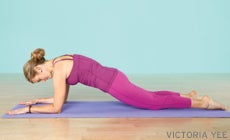
Virabhadrasana I is an ideal pose for preparing for Ustrasana because both poses call for the same actions in the legs and the pelvis.
From Downward Dog, step your right foot forward and bring your front knee directly over your front ankle. Turn your back toes out slightly and square your hips. Activate your breath: Inhale slowly and deeply so you feel as though your breath moves down into your pelvis.
Now imagine there’s a corset wrapped around your waist beneath the skin and between your hips and your rib cage. (We’re referring to the transversus abdominis, the deepest abdominal muscle and a low-back stabilizer, and its connecting thoracolumbar fascia.)
As you inhale, try to expand this corset along with your pelvis, rib cage, chest, and upper back. As you exhale, tighten this corset to actively press the air out. Continue to use this same dynamic breath throughout the sequence. These actions will create buoyancy in your chest and facilitate the opening of your heart, laying a foundation on which to backbend and powerfully move into Ustrasana.
With your breath well established, set up your lower body, the foundation of your pose. Hug your ankles and shins into the centerline of your body to activate your inner thigh muscles. Engage the gluteal and hamstring muscles on the back leg by pressing your thighbone back, as though you were trying to lift the back leg off the ground.
On your exhalation, scoop your tailbone down and forward and tuck your hips under. Move the back of the pelvis down and away from the back ribs.
Finally, engage and lift the pelvic floor. Pull the pubic bone, the tailbone, and the two sitting bones toward one another and try to lift the space between them. Keep that energy extending all the way to the crown of your head.
To come upright, extend through your back leg into the floor and peel your belly, front hip points, and lower front ribs up off your thigh, lifting from the base. Lastly, extend your arms up. Marry these actions with active breath. Maintain space between the back of your hips and the back of your lower ribs by moving them away from each other as you inhale. These actions will help you maintain length in your spine and prevent low-back compression as you powerfully lift your heart toward the sky.
2. Purvottanasana (Upward Plank Pose)
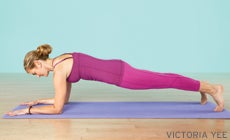
This pose continues to teach the actions that create strong legs and a powerful breath, core, and back body.
Sit on your mat and place your feet on the floor, hip-distance apart and parallel. Take your hands behind you, shoulder-distance apart, so that your fingers point forward and are slightly turned out. Lengthen your spine, bend your elbows, and gently draw them toward each other while you expand and open your chest. Bring the crown of your head in line with the rest of your spine.
Turn your awareness inward and inhale deeply so that the inner cavity of your body starts to swell. On your exhalations, shrink your deep core muscles inward and soften your lower ribs.
Hug your ankles, feet, and shins toward each other to activate your inner thighs. Engage and lift your pelvic floor. Press your feet down and lift your hips to come into the pose. Isometrically pull your feet back toward your hands to engage your hamstrings and gluteals.
Try to widen your entire back body from your thighs, sitting bones, pelvis, waistline, ribs, and the back of your shoulders. Use your strong inner thighs and gluteal muscles to stop the inner thighs from turning toward the sky when you press your tailbone up and lift your hips.
You’ll use your breath and core muscles to hold the shape of Purvottanasana and to stabilize your spine. As your hips rise, keep your deep abdominal muscles engaged. Draw your front lower ribs into your body, and elongate your spine and the back of your neck.
Once again, slightly bend your elbows toward each other to help broaden your chest and collarbones. Root your fingertips into the floor, initiating internal rotation of your hands and forearms. Then, externally rotate your upper arms and slowly straighten them while lifting your heart. Move your shoulder blades away from your neck and draw the tips of your shoulder blades in toward your heart to expand and lift your chest.
As you hold Purvottanasana for five powerful breaths, connect to your own internal power, noticing how your body and breath are strongly and safely sustaining this challenging shape. When you feel ready, slowly lower your hips to come down. Take a moment to integrate all of the hard work you just did.
3. Eka Pada Bhekasana (One-Legged Frog Pose), variation
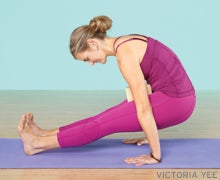
Eka Pada Bhekasana, and its many variations, is one of the best poses to open your thighs and hip flexors, making this a fitting preparation for Ustrasana. To prepare, bring your mat and a blanket to a wall. Place the blanket on the floor, right against the wall.
Come into a Low Lunge on your mat, facing away from the wall. Bring your hands onto the floor, move back toward the wall, and nestle your knee into the edge where the wall and floor meet. Your back shin will be up against the wall. Move your buttocks back toward the wall and aim to get your back thighbone as perpendicular to the floor as you can without strain. Be sure that your knee is in line with your hip (not placed wider than your hip). If full flexion of your knee is too much, come away from the wall, bringing your back knee and hips forward until you feel comfortable.
Otherwise, bring your hands to your front thigh, and move your buttocks and upper body back toward the wall. Keep your inner and outer ankle lengthened equally so that your foot extends straight up toward the ceiling. Guide your back foot to the outer hip of your back leg (rather than directly behind your buttocks). Hug both of your ankles and shins toward the centerline of your body, engaging your inner thighs.
As you did in the previous two poses, engage your gluteal and hamstring muscles to prevent the back thighbone from moving forward as you move your tailbone down and forward. Try to move the back of the pelvis down and your front hip points up, bringing your pelvis toward a neutral position.
Hold this pose for five breaths, allowing your breath to focus your attention inward. Listen to the rhythm of your breath and to the way your body feels. This will help you move deeper or cue you to back off with confidence and ease. Bring your hands to the floor and slide your knee off your blanket and away from the wall to come out of the pose. Repeat on the second side.
4. Setu Bandha Sarvangasana (Bridge Pose)
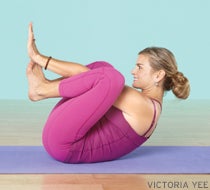
In Bridge Pose, you’ll use the support of the floor to begin to open into the shape of Ustrasana on your back.
Lie on your back with your feet on the floor. Your feet should be in line with your outer hips and parallel to each other. Bring your arms alongside your body and externally rotate your shoulders so that your palms face up.
On your first inhalation, consciously release your lower ribs toward the floor. On subsequent inhalations, feel the inner cavity of your body swell, supporting you from the inside out. On your exhalations, feel your deep core muscles contract.
Hug in your feet and shins to engage your inner thighs. Press your sitting bones into the earth and arch your back slightly. Widen the back of your pelvis and low back. Press your feet into the floor, and energetically pull your feet back toward your buttocks until you can feel your hamstrings and gluteal muscles engage. Scoop your tailbone up and, on an exhalation, lift your hips. Bring your hands under your back and interlace your fingers.
Bring awareness to five full cycles of dynamic, full-body breath. Release your hands and lower your hips to the floor.
5. Ustrasana (Camel Pose)
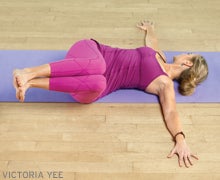
In the previous poses, you’ve engaged your legs, back body, and core to prepare you for Ustrasana. By continuing to tune in to your breath, you can create a safe and strong expression of this deep and challenging heart opener.
A key component in Camel Pose is to keep the breath moving continuously. Be sure to breathe into the lower back to keep a sense of spaciousness there.
Come onto your knees with your toes curled under. Bring your hands to your hips. Press your toes into the floor and hug your ankles and feet toward each other to engage your inner thighs. Lift your gluteal muscles and pull the tops of your thighs back.
Isometrically move your thighs apart laterally to widen the back of your pelvis and waistline. Scoop your tailbone down and forward.
Inhale and lift your pelvic floor, frontal hip points, low belly, and the back of your lower ribs away from the tops of your thighs. Use your inhalations to spread your rib cage laterally as your spine lengthens and your heart lifts. Use your exhalations to gently tighten the inner corset around your waist to support your lower back.
Externally rotate your arms and bring your hands to the back of your hips with your fingers pointing downward. Begin to lean back, taking your heart to the sky. Breathe deeply and listen to your body. If you feel comfortable in this stage of the pose, take your hands to your heels. Once you feel powerful and at ease here, uncurl your toes and press the tops of your feet into the mat to come into the full expression of the pose.
Breathe here for five spacious breaths and allow your heart and chest to soften and broaden. To come out of this pose, root down strongly through the back of your hips and thighbones. Inhale, engage your belly, and lift your chest upward (but not forward) to come up-right. Your head will come up last. Come into Downward-Facing Dog to release and elongate your spine. To finish, come into Parsvottanasana (Intense Side Stretch) and Uttanasana (Standing Forward Bend). Then move into Ardha Matsyendrasana (Half Lord of the Fishes Pose) to broaden your back muscles. Next, take Balasana (Child’s Pose) and end with a long Savasana (Corpse Pose).
In this sequence, you’ll experience both your inner and outer strength. Take a few moments afterward to savor it. Appreciate the support you can create with your own body and mind, which will pave the way for you to open and courageously express your heart on and off your mat.
Leigh Ferrara is a freelance writer and yoga teacher in San Francisco.